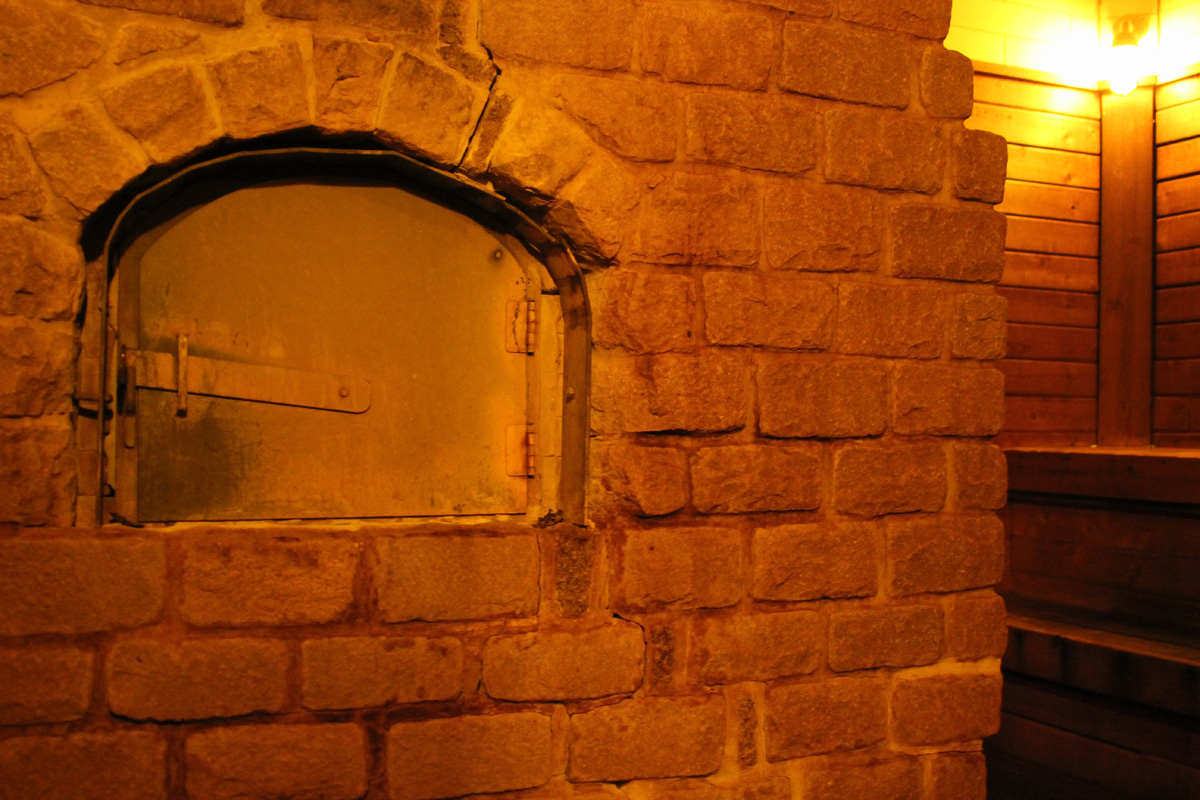“I WANTED TO BRING PASTA TO THE forefront. I wanted to showcase pasta in different ways, and really show the craft of it,” Sarah Grueneberg said as I met her one morning at Monteverde, her pasta-focused Italian restaurant on Madison in the West Loop.
That’s a mission statement a lot of Italian restaurants might try to claim, but one reason to give it more credence at Monteverde is that “showing the craft of it” is built into the architecture of the restaurant. Behind the bar, where most places would put flat screen TVs or a mirror and shelves of hipster liquor, designer Karen Herold built the restaurant what’s essentially a pasta stage—a workspace, raised high enough that you can watch a pasta-maker at work all through the evening, with a tilted mirror giving you an overhead look at pasta-making in action. And by “in action,” it doesn’t mean “if they happen to be working while you’re sitting there”—for certain dishes, the pasta is literally made after the customer orders them, all through service. That’s not just fresh pasta, it’s newborn.
“‘Could we make pasta to order?’ seemed like a very challenging thing to accomplish,” she said. “But when you can make a pasta that’s really simple and made like that, it’s really rewarding as well.”
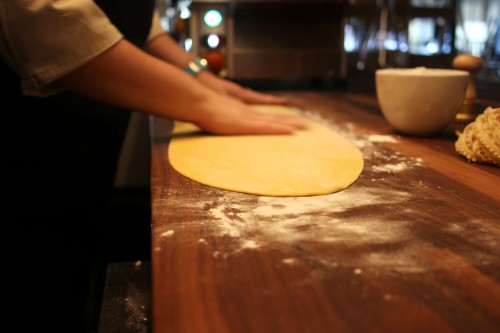
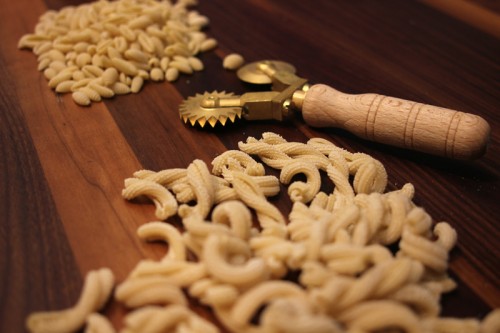
She wanted to make pasta to order for the simple reason that it is made to order in parts of northern Italy, where egg pasta predominates. “In higher-end restaurants, you order the ravioli and the guy makes it to order and fills it,” she said. “We have a terminal, and they get the order and they make them and they go in the water. That’s why they’re sooo delicate.”
“But other kinds of pasta benefit from drying out a bit, don’t they?” I asked, sitting as we were surrounded by frizzy pastas hanging from racks above us.
“Yes, that’s the southern Italian style,” she said. “Cucina povera, poor food, they weren’t putting eggs in their dough. The pastas that you want to dry are the semolina-water kind. Those are made through an extruder, so the gnochetti sardi are made here, the fusilli that goes on the ragu napoletana is made here. And we have two dry pastas—one, the orrechiete that goes in the wok, is from Abruzzo, and the cacio e pepe is gentile pasta from Gragnano, the birthplace of dried pasta.”
Clearly Grueneberg is committed to regionalism as a guiding principle in Italian dishes—”At Spiaggia, we really focused on being true to Italian food and culture. And when I was a chef there, I really wanted to teach people the regionality, and not breaking the rules,” she said. “If there’s a different pasta from a region, then you should try to find a cheese from that region. Pecorino romano shouldn’t be on a northern Italian dish. That’s like the third level of Italian cuisine, understanding the regionality.”
But she’s not exactly slavish to it. “Here, I’m able to break the rules a little bit. I found a little more confidence in myself, and wanting to create dishes that push the envelope,” she said. “That’s why we have the pasta tipica and the pasta atipica section, Italy’s pasta and our pasta.”
That makes sense—first, show your respect for the tradition, then build on it. But you may have caught a word in there that didn’t seem to belong.
Did she really just say “wok?”
Gallery: Making pasta to order at Monteverde
YOU DON’T HAVE TO PRY HER MENTOR’S NAME out of Sarah Grueneberg—”Tony Mantuano taught me everything I know about pasta,” she volunteered off the bat. She was a Texan who’d worked at Brennan’s, a classic fine dining restaurant in Houston, before she came to Chicago to work at Spiaggia. The experience completely rearranged her whole conception of what Italian food could be—”I struggled for the first six months, I thought I’d made a mistake. I didn’t understand this food, I didn’t understand how olive oil could be a sauce. I didn’t understand the simplicity—simplicity is so hard. Italians make it look easy, but it’s not easy.”
But she rose to be chef under Mantuano, and then a contestant on Top Chef’s season 9 in 2011, where she became the second most successful woman chef from Chicago on the show, coming in as first runner-up to Austin’s Paul Qui. When Spiaggia announced plans to close for a makeover at the beginning of 2014, she decided to leave and begin work on her own ideas for a restaurant, traveling extensively in Europe. It was there that she was given the restaurant’s name—Andrea Bezzecchi, the balsamic vinegar merchant who provided the system of barrels of balsamic vinegar aging above the pasta-making station, translated her German name (which means “green mountain”) into Italian, and called her Sarah Monteverde as they traveled. (She says her reaction was, “You mean, I didn’t have to grow up a Grueneberg?”)

Sarah Grueneberg and Meg Sahs
But Grueneberg is not the only one with a history like that at the restaurant. The other half of the team behind Monteverde is Meg Sahs, and the two of them met working on the line at Spiaggia. Meg also rose through Spiaggia and when the restaurant got the contract to operate Terzo Piano at the Art Institute of Chicago in 2009, she was named its head chef. In 2012, however, she decided to leave with plans of opening her own restaurant, too—only, she didn’t want to be the chef.
“I had never worked front of house. This is my first time overseeing the operation officially,” Sahs explained. “At Terzo Piano I helped a lot with the overall management of the restaurant, which is what I really enjoyed. I’m happy to get out of the kitchen—not that I don’t still love cooking, I do. But I always came at it from a different perspective than Sarah—she’s a creative thinker, I’m a logistical thinker.”
“I really wanted to cook for the Italian friends I have. And then I realized, when they come here, they want to see something different.”
But they had different plans—Sarah was looking to open a restaurant through the Levy restaurant group, which owns Spiaggia, and Meg wanted to open in Glen Ellyn, where she and her husband live. It took the Sahs running into Sarah and Tony Mantuano in Napa, where they were participating in the San Pellegrino Almost Famous competition, to connect the two at last. Sarah and her now-fiancé Jaime Canete met the Sahs for dinner at Ad Hoc, and Sarah mentioned to Meg that she was no longer planning to open with Levy. She describes the moment like a scene in the movie, orchestra swelling as a business match is made and destiny fulfilled—”I saw it in her eyes. She was searching, she knew she needed a chef. We both found the partner we were looking for—I was looking for someone who had a vast amount of business knowledge, who could be the brain, basically, and allow me to drive the concept and the creative and the food.”
Sahs said that the restaurant really follows Grueneberg’s vision for a rustic Italian restaurant. But she was the one who found the space on Madison, which is two blocks south of the Randolph Street strip but feels like another world of sports bars and chain restaurants. (At least for now; Monteverde is probably changing that.) The space had started to be developed by the landlord as an Italian restaurant for another chef, which never opened—but as soon as Meg saw it, she called Sarah and said “I think I found our restaurant.” There wasn’t much in the way of design in place, but they could see their restaurant in the space anyway. Sarah said “the only thing we inherited were the French doors. But can’t you see, in the summer, those opening onto a patio, like they do in Italy?”
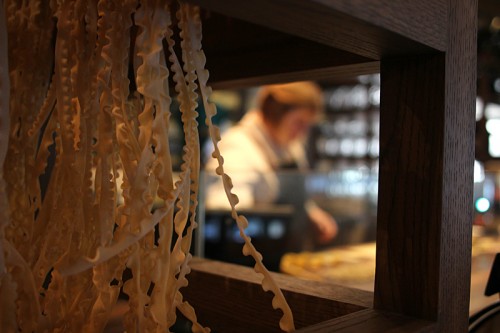
OKAY, BUT GRUENEBERG REALLY DID say “wok,” didn’t she?
After she left Spiaggia, “I got to go to Asia, I really love Asian food, and I went to southeast Asia in—’09? ’10? Right after Top Chef. And noodles are very different—it was like rice noodles, and egg noodles, and ramen. I wanted to search out, where does pasta come from? And so the wok came from that.”
“I really wanted to cook for the Italian friends I have, I wanted them to come in and say, wow, she’s making Italian food the way it should be. She respects our country,” she said. “And then I realized, when they come here, they want to see something different. Because here we truly can break the rules. And that’s when—what if we put a simple pasta in a wok? We can achieve flavor that you can’t achieve by an ingredient.”
“So to me the wok is an ingredient. To me the only way to use a tomato is to fry it hard—that’s the only way to get a flavor that doesn’t taste like a canned sauce. It’s got to be like high heat, fried, and that’s what the wok does.”
And that’s why there’s a wok in the kitchen. So what’s “green mountain” in Chinese?
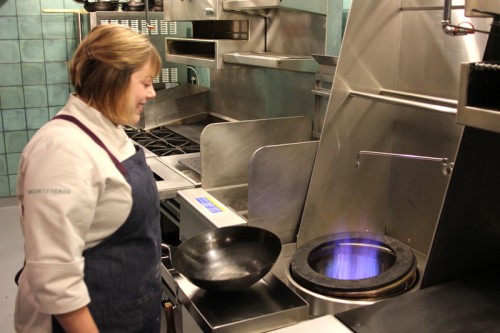
Michael Gebert is al dente as editor of Fooditor.
Latest
Join the Discussion
After you comment, click Post. If you're not already logged in you will be asked to log in or register with Disqus.














